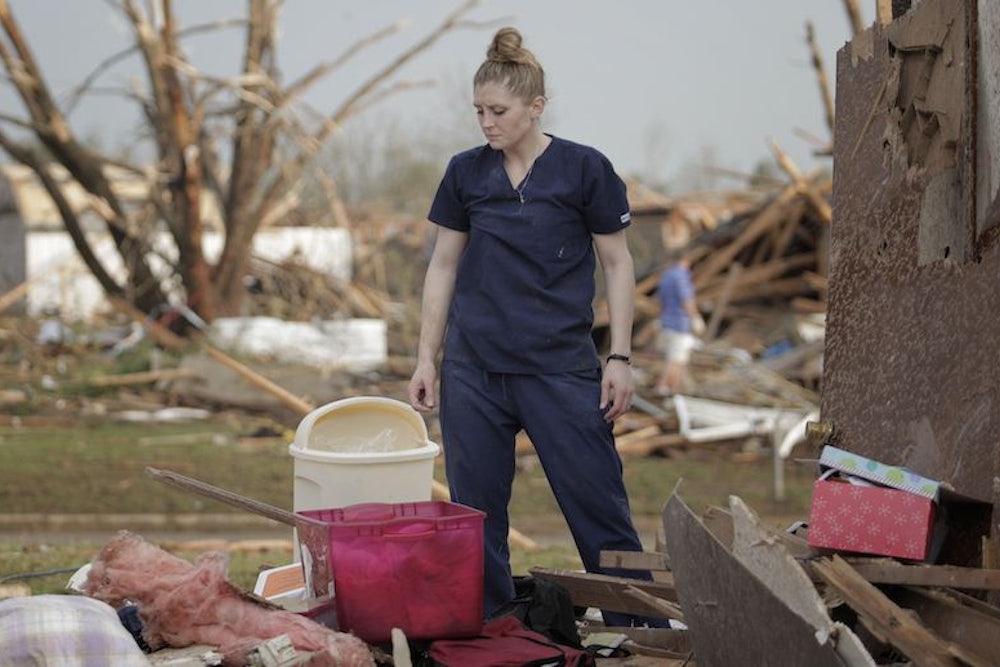Lots of people have been expecting Monday’s devastating tornado in Oklahoma to provoke yet another congressional debate over disaster funding. It may not happen, at least right away: It depends on how expensive the relief and rebuilding effort gets, and how quickly. But the issue of how to pay for disaster relief remains very contentious—and is already forcing Oklahoma’s two Republican senators to reckon with their own views on the virtues of austerity.
In 2011, as part of the debt-ceiling deal, Congress and the president agreed to create a disaster contingency fund—in effect, to put some money aside so that the federal government could dole it out, quickly, in case of a hurricane, earthquake, and so on. The fund grows by a preset formula, based on the cost of previous disasters. And it hasn’t always been enough, because natural disasters have been more expensive—thanks to population growth, settlement along the coasts, and, maybe, climate change. (Dave Weigel of Slate and Brad Plumer of the Washington Post gave the full backstory on this a few months ago.)
By the time Hurricane Sandy hit, in late 2012, earlier disasters had depleted the fund. Getting relief to the stricken Northeast meant appropriating new money, and that sparked the memorable debate over whether Congress needed to find offsetting cuts to pay for relief funds in the Northeast. Among those conservatives making the case for offsets were Oklahoma senators Tom Coburn and James Inhofe.
Already reporters have been asking those two whether they’ve changed their minds, now that their state is the one that needs relief. Coburn, to his credit, hasn’t wavered: Appropriating more money for Oklahoma would require offsetting cuts, he said, just like appropriating more money for New York and New Jersey did. Inhofe, however, said on MSNBC that the two situations “are totally different.” The reason? Because this bill wouldn’t have the pork projects that the Sandy relief bill did. It’s not clear how exactly Inhofe plans to keep a new bill free of pork.
The question may be irrelevant, at least for the moment. Speaking on Tuesday afternoon, White House Press Secretary Jay Carney said that the fund actually has enough money right now. But the fund could run out in the coming weeks, and if it doesn’t, it seems quite possible (some would say likely) it will run out later this year, much as it did last year. So it’s worth pondering: Is disaster relief getting enough funding? Like every other agency affected by the Budget Control Act and sequestration, FEMA funding has fallen. Matt Vasilogambros of the Atlantic explains:
Due to the massive cuts brought on by sequestration, the disaster relief section of FEMA's budget will lose $1 billion this year. Following the devastation from Hurricane Sandy earlier this year, FEMA Administrator Craig Fugate said FEMA's Disaster Relief Fund would pay out a total of $10.8 billion to storm victims by the end of the fiscal year. That would leave $2.5 billion in its disaster fund for the rest of the year.
While testifying before Congress in March, he said he had concerns that there would be enough money to help state and local governments that help rebuild damaged infrastructure... Sequestration also cut $1.9 billion from transportation repair funding and other disaster programs.
Under Obama, FEMA has generally gotten high marks for its responsiveness, in no small part because the administration made a concerted effort to avoid another fiasco like the Bush administration’s response to Hurricane Katrina. Appointing Fugate, who once ran disaster relief in Florida, was a product of that effort. But personnel can’t do their jobs without enough resources.
Conservatives say they understand—that they merely want to pay for the extra spending, in their preferred way. But their preferred way is to cut spending elsewhere, at a time when discretionary spending is approaching historic lows and when the only kind of entitlement cuts they will tolerate are reductions in benefits. That’s not the choice I’d make and, I suspect, it’s not the choice most Americans would make, either. Time will tell whether Oklahoma’s senators agree.
